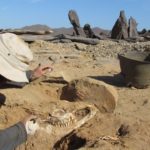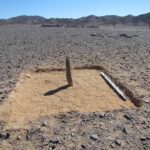Wadi Khashab
-
Project name:
Wadi Khashab Project (sub-activity of the Berenike Project)
-
Type of site:
Ceremonial complex (cemetery?), megalithic installations
Location:
Egypt
Eastern Desert
Red Sea HillsDating:
– Neolithic (5th millennium – 2nd millennium BC)
Most interesting finds:
– complex of human and animal burials surrounded by stone stelae
– stone stelae and pavements
– separate tumuli
History of research:
Investigated by the PCMA mission in:
2010–2015
Type of research:
Survey, excavations
Directors:
Piotr Osypiński
Co-operating institutions:
– Polish Centre of Mediterranean Archaeology, University of Warsaw
– Patrimonium Foundation
– Ministry of State of Antiquities, Egypt
Additional information:
National Science Center grant no. UMO-2012/07/N/HS3/04056 (Preludium 4): “The place and significance of prehistoric sacral complex at Wadi Khashab, Egypt, Eastern Desert”, carried out in the years 2014–2015.
Description of the site and research:
The Red Sea Cuesta has not been extensively studied archaeologically. In antiquity (as well as today), the area was sparsely populated but attractive due to a wealth of valuable mineral ores.
The very interesting prehistoric site at Wadi Khashab was studied between 2010 and 2015. The unnaturally geometric stone structure, noticed on satellite imagery, was first interpreted as the remains of Roman military infrastructure. The archaeological team determined the actual chronology and character of this feature only after visiting the site. It was established that a ceremonial complex functioned there in the 5th millennium BC, located almost exactly half-way on the road linking the Nile Valley with the Red Sea coast.
The central feature of the site is a human burial, which had been robbed several times already in antiquity, surrounded by buried livestock – cattle and sheep. The deliberate arrangement of the animal bodies suggests that each burial had a very symbolic meaning. The skeletons themselves also provided a wealth of data on the morphology of Neolithic animals. Contrary to the widespread opinion in scientific debate about the Asian origin of domesticated cattle, they pointed to its local, African, origin. Some elements of the skeletons also indicated that the animals had adapted to nomadic husbandry.
The whole complex was fenced with a structure resembling a zeriba made of stone slabs set vertically. The burial of a two-year-old child on the edge of the enclosure remains a mystery. Its relationship to the original human burial (in the center) and the animal burials is unclear, although the grave furnishings suggest it is also of Neolithic date. The connection of the stone stelae and pavements, located outside the enclosure, to the complex is uncertain as well.
The ceremonial complex at Wadi Khashab was undoubtedly an important feature of the cultural landscape for the later communities crossing the Red Sea Hills. Fragments of pottery collected from the surface of the site attest to the presence of the so-called C-Group people (cattle herders, inhabiting the Nile Valley in the 2nd millennium BC); the area was also settled in the Roman period (beginnings of the Common Era).
Results of the research:
Season by season – “PCMA Newsletter”:
Osypiński, P., Osypińska, M., Zych, I. (forthcoming). Wadi Khashab. Unearthing late prehistory in the Eastern Desert of Egypt. Peeters.
Osypiński P. (2019). Wadi Khashab, Pustynia Wschodnia, Egipt. In M. Chłodnicki, P. Polkowski (Eds.), Gdy Sahara była zielona. Polskie badania nad prahistorią Afryki Północnej (When Sahara was Green. Polish archaeological research on the prehistory of North Africa), Archaeological Museum in Poznan, 141–144.
Osypiński, P., Osypińska, M. (2015). Wadi Khashab ceremonial complex – manifestation of the cattle keepers presence in the Eastern Desert before the end of the 5th millennium BC, Azania, Archaeological Research in Africa, 51 (2), 257–281.
Osypiński, P., Osypińska, M. (2014). Wadi Khashab – Ceremonial Complex of Cattle Keepers in the Egyptian Eastern Desert, Season 2014, Nyame Akuma, 82, 84–90.
Gallery:
-
1. Exploration and documentation of animal burials / Prace dokumentacyjne i eksploracja pochówków zwierzęcych. Fot. P. Osypiński
-
2. Skull of a bull (F.4) with damaged frontal part and horns (bucranium) / Czaszka byka (F.4) z uszkodzoną partią czołową i rogami (bukranion). Fot. M. Osypińska
-
3. One of the smaller stone stelae still standing in original position / Jedna z mniejszych steli kamiennych wciąż tkwiących w pierwotnej pozycji. Fot. P. Osypiński
-
4. View of the southern, explored part of the cemetery / Widok na południową partię cmentarzyska objętą badaniami wykopaliskowymi. Fot. M. Osypińska






